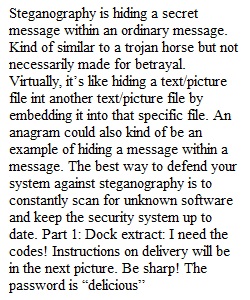


Q CYBR 1100 Introduction to Cyber Security Steganography Lab In this assignment you will be using a steganography tool to hide and unhide files from images. The tool we will be using is called STEGHIDE. This lab will help you realize that steganography is NOT something that can be detected by just looking at an image file or listening to an audio file. Turn in: • A lab report discussing the following: o What is steganography? Provide a description of how it works. [30 points] o What are possible ways to prevent steganography? Might require research to answer. [15 points] o Provide answers to all the specific investigation questions (on the second page, in bold) [55 points] Due: Please submit on Canvas. Provide your answers in a word document. Read the entire worksheet before starting the lab. Steganography Investigation: Embedded Images Folder: The embedded images folder contains image originals and copies that contain an embedded message. Filename.jpg is the original whereas Filename1.jpg contains embedded information. Clean Images Folder: Images in the clean images folder do not contain any hidden messages. You can use these to embed your secret messages into. Part 1: Extract secret message. 1. Select an image pair (embedded and original based on the naming scheme indicated above) from the embedded images folder and copy them to the desktop. 2. (10 points) Examine both images. Do you notice any differences in the image? What about the file size? What about the file hash values? a. Use the WinMD5 program. Also look at the sizes and view them in Paint or other picture viewing program. 3. Run steghide.exe from the command line to see the list of options b. Use the CMD shortcut on the desktop. c. Use the steghide command line options --extract and -sf to extract the secret message from the embedded image. steghide --extract -sf filename.jpg (Note: you have to replace carrierfile.jpg with the actual file name of your image file) d. Use the passphrase s3cr3tw0rd to unlock the message e. (30 points) Find the extracted secret message. What is the message? i. Repeat this exercise for all the images with embedded messages full points only awarded if you have all three messages 4. Repeat for all embedded/original pairs in the embedded folder Part 2: Create your own package. 1. Create a text document (.txt) using notepad, containing a message that you would like to embed into an image and save it on the desktop 2. Copy an image from the Clean Images Folder to the desktop. 3. Run steghide.exe from the command line to see the list of options a. Use the command line options --embed, -cf, and -ef to embed your secret message file into the image copy you selected steghide --embed -cf cleanpicture.jpg -ef filetohide.txt (Note: you have to replace cleanpicture.jpg and filetohide.txt with the actual file names of the picture and the file containing the text message) b. Enter the passphrase you would like to use when extracting the secret message c. Delete your secret message text file 4. (25 points) Examine your embedded image and the original; can you see any differences in the images? What about the file's size? 5. Run steghide.exe with the command line options --extract and -sf to extract your secret message. This is similar to Part 1. a. Enter your passphrase b. Recover your secret message.
View Related Questions